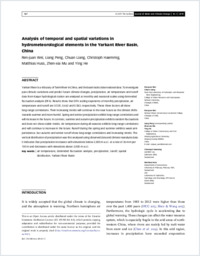Analysis of temporal and spatial variations in hydrometeorological elements in the Yarkant River Basin, China
- Wei, Ren-juan River Engineering, College of Water Resource and Hydropower, Sichuan University, Chengdu, China - Sichuan Water Conservancy Vocational College, Chengdu, China
- Peng, Liang College of Civil Engineering, Xinjiang Agricultural University, Xinjiang Urumqi, China
- Liang, Chuan River Engineering, College of Water Resource and Hydropower, Sichuan University, Chengdu, China
- Haemmig, Christoph GEOTEST AG, Zolikhofen, Switzerland
- Huss, Matthias Department of Geosciences, University of Fribourg, Switzerland
- Mu, Zhen-xia College of Civil Engineering, Xinjiang Agricultural University, Xinjiang Urumqi, China
- He, Ying College of Civil Engineering, Xinjiang Agricultural University, Xinjiang Urumqi, China
-
01.03.2019
Published in:
- Journal of Water and Climate Change. - 2019, vol. 10, no. 1, p. 167–180
English
Yarkant River is a tributary of Tarim River in China, and the basin lacks observational data. To investigate past climatic variations and predict future climate changes, precipitation, air temperature and runoff data from Kaqun hydrological station are analysed at monthly and seasonal scales using detrended fluctuation analysis (DFA). Results show that DFA scaling exponents of monthly precipitation, air temperature and runoff are 0.535, 0.662 and 0.582, respectively. These three factors all show long- range correlations. Their increasing trends will continue in the near future as the climate shifts towards warmer and more humid. Spring and winter precipitation exhibit long-range correlations and will increase in the future. In contrast, summer and autumn precipitation exhibits random fluctuations and does not show stable trends. Air temperature during all seasons exhibits long-range correlations and will continue to increase in the future. Runoff during the spring and summer exhibits weak anti- persistence, but autumn and winter runoff show long-range correlations and increasing trends. The vertical distribution of precipitation was first analysed using observed data and climate reanalysis data. It indicates that precipitation increases with elevations below 2,000 m a.s.l. at a rate of 26 mm per 100 m and decreases with elevations above 2,000 m a.s.l.
- Faculty
- Faculté des sciences et de médecine
- Department
- Département de Géosciences
- Language
-
- English
- Classification
- Hydrology
- License
- License undefined
- Identifiers
-
- RERO DOC 324671
- DOI 10.2166/wcc.2018.111
- Persistent URL
- https://folia.unifr.ch/unifr/documents/307735
Statistics
Document views: 107
File downloads:
- hus_ats.pdf: 123
